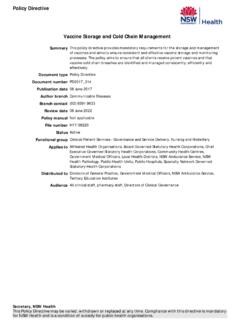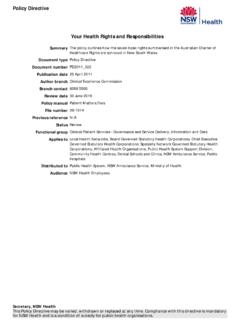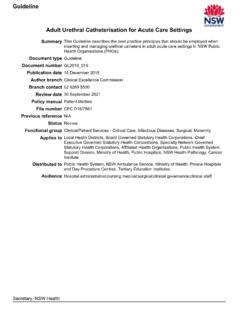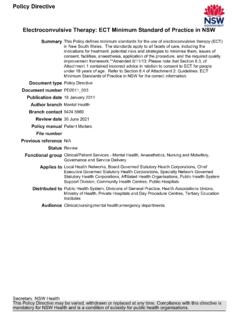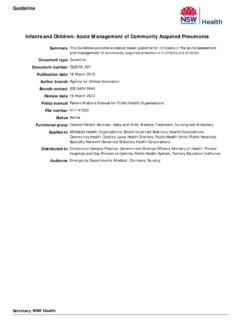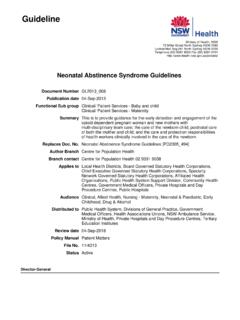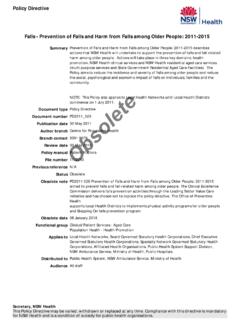Transcription of User-applied Labelling of Injectable Medicines, Fluids and ...
1 Policy Directive Ministry of Health, NSW. 73 Miller Street North Sydney NSW 2060. Locked Mail Bag 961 North Sydney NSW 2059. Telephone (02) 9391 9000 Fax (02) 9391 9101. User-applied Labelling of Injectable Medicines, Fluids and Lines Document Number PD2016_058. Publication date 22-Dec-2016. Functional Sub group Corporate Administration - Governance Corporate Administration - Purchasing Clinical/ Patient Services - Nursing and Midwifery Clinical/ Patient Services - Medical Treatment Population Health - Pharmaceutical Summary This Policy Directive sets out the requirements for User-applied Labelling of Injectable medicines, Fluids and lines in NSW Public Health Organisations and NSW Ambulance.
2 Replaces Doc. No. User applied Labelling of Injectable Medicines, Fluids and Lines [PD2012_007]. Author Branch Clinical Excellence Commission Branch contact Clinical Excellence Commission 02 9269 5500. Applies to Local Health Districts, Board Governed Statutory Health Corporations, Chief Executive Governed Statutory Health Corporations, Specialty Network Governed Statutory Health Corporations, Affiliated Health Organisations, Community Health Centres, NSW Ambulance Service, Public Hospitals, NSW Health Pathology, Cancer Institute (NSW). Audience Clinical, administration staff Distributed to Public Health System, Divisions of General Practice, Health Associations Unions, NSW Ambulance Service, Ministry of Health, Public Hospitals, Private Hospitals and Day Procedure Centres, Tertiary Education Institutes Review date 22-Dec-2021.
3 Policy Manual Not applicable File No. 16/350. Status Active Director-General This Policy Directive may be varied, withdrawn or replaced at any time. Compliance with this directive is mandatory for NSW Health and is a condition of subsidy for public health organisations. POLICY STATEMENT. User-applied Labelling OF Injectable MEDICINES, Fluids AND LINES. PURPOSE. This Policy Directive sets out the requirements for User-applied Labelling of Injectable medicines, Fluids and lines in NSW Public Health Organisations and NSW Ambulance. MANDATORY REQUIREMENTS. All NSW Health Public Health Organisations and NSW Ambulance are to apply the requirements set out in the Australian Commission on Safety and Quality in Health Care's National Standard for User-applied Labelling of Injectable Medicines, Fluids and Lines ( Labelling Standard).
4 IMPLEMENTATION. NSW Ministry of Health is responsible for: Providing access to User-applied labels through state contracted suppliers (cost of labels being dependent on demand). NSW Clinical Excellence Commission is responsible for: Monitoring the implementation of this policy by reviewing the completed implementation checklists Providing resources to support implementation and ongoing compliance with this policy Informing the State Forms Management Committee and HealthShare NSW. Procurement Services of any changes to the Labelling Standard. Chief Executive is responsible for: Assigning responsibility, personnel and resources to implement and comply with this policy.
5 Director of Clinical Governance is responsible for: Reporting the status of the policy implementation to the NSW Clinical Excellence Commission by returning a completed Implementation checklist (Attachment ). within twelve months of publication of the policy. Drug and Therapeutics Committees are responsible for: Providing local oversight of safe implementation of this policy. Health Service Managers are responsible for: Ensuring relevant labels are available for use in clinical areas Ensuring clinicians receive education on User-applied Labelling Monitoring implementation and compliance with the policy.
6 PD2016_058 Issue date: December-2016 Page 1 of 2. POLICY STATEMENT. REVISION HISTORY. Version Approved by Amendment notes December 2016 Deputy Secretary, Updated to include requirements of the ACSQHC National (PD2016_058) Governance, Standard for User-applied Labelling of Injectable Medicines, Workforce and Fluids and Lines. Corporate January 2012 Director General, New policy (PD2012_007) NSW Health ATTACHMENTS. 1. User-applied Labelling of Injectable Medicines, Fluids and Lines: Procedures. PD2016_058 Issue date: December-2016 Page 2 of 2. User-applied Labelling of Injectable Medicines, Fluids and Lines PROCEDURES.
7 Issue date: December-2016. PD2016_058. User-applied Labelling of Injectable Medicines, Fluids and Lines PROCEDURES. CONTENTS. 1 BACKGROUND ..1. Related documents ..1. 2 PROCEDURES ..1. 3 RESOURCES ..1. 4 5 LIST OF ATTACHMENTS ..3. Implementation checklist ..3. PD2016_058 Issue date: December-2016 Contents page User-applied Labelling of Injectable Medicines, Fluids and Lines PROCEDURES. 1 BACKGROUND. Failure to recognise the correct container (for example; bags, bottles, syringes) for Injectable medicines and Fluids , or the correct conduit (for example; administration lines, invasive monitoring lines, catheters or burettes) can result in an administration error.
8 Use of multiple label design; colour; size and content, and lack of use of labels in certain circumstances, has also contributed to medication safety incidents. Where multiple parenteral and enteral lines are in use, incorrect line selection has contributed to adverse patient outcomes from administration of Fluids and medicines by an incorrect route. The Australian Commission on Safety and Quality in Health Care (ACSQHC) has developed the National Standard for User-applied Labelling of Injectable Medicines, Fluids and Lines ( Labelling Standard) to ensure accurate communication of Injectable medicines and Fluids information through standardised User-applied Labelling .
9 The Labelling Standard replaces the 2012 National Recommendations for User-applied Labelling of Injectable Medicines, Fluids and Lines(1). Consistent with the Labelling Standard, NSW Health provides access to User-applied labels through state contracted suppliers for use in all NSW Public Health Organisations. Related documents NSW Health Policies: Medication Handling in Public Health Facilities Australian Commission on Safety and Quality in Health Care: National Standard for User-applied Labelling of Injectable Medicines, Fluids and Lines 2 PROCEDURES. All NSW Public Health Organisations and NSW Ambulance are to: Implement this policy Apply requirements as set out in the Labelling Standard Ensure there is no customisation or alteration of Labelling Standard labels.
10 3 RESOURCES. A range of resources to support implementation of the Labelling Standard are available on the ACSQHC webpage. Resources are also available on the Clinical Excellence Commission User-applied Labelling webpage. PD2016_058 Issue date: December-2016 Page 1 of 3. User-applied Labelling of Injectable Medicines, Fluids and Lines PROCEDURES. 4 REFERENCES. 1. Australian Commission on Safety and Quality in Health Care. National Standard for User-applied Labelling of Injectable Medicines, Fluids and Lines. Sydney: ACSQHC, 2015. PD2016_058 Issue date: December-2016 Page 2 of 3.

